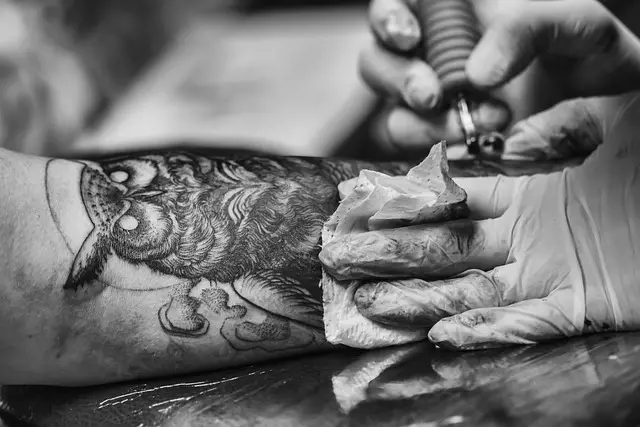Contents
How to waterproof a tattoo for swimming
Introduction
Tattoos are not just ink on the skin; they’re personal expressions of art and identity. Whether it’s a meaningful symbol, a cherished memory, or simply a beautiful design, tattoos hold significance for many individuals. However, when it comes to activities like swimming, protecting tattoos becomes paramount.
Swimming exposes tattoos to various elements, including water, chlorine, and UV rays, which can all contribute to fading, distortion, or even damage to the tattoo. Therefore, understanding how to effectively waterproof tattoos for swimming is crucial for preserving their vibrancy and integrity over time.
In this article, we’ll delve into the importance of protecting tattoos while swimming and provide practical tips for waterproofing tattoos. From waiting for proper healing to using waterproof sunscreen, we’ll cover everything you need to know to ensure your tattoos stay vibrant and beautiful, even when you’re diving into the pool or splashing in the ocean. So, let’s dive in and explore the best ways to safeguard your tattoos while enjoying your aquatic adventures.
Understanding the Need for Waterproofing
Tattoos are not only intricate works of art but also investments in self-expression and personal identity. However, when it comes to activities involving water, such as swimming, tattoos face unique challenges that require careful protection and maintenance.
Explanation of why tattoos need protection during swimming activities:
Tattoos are created by injecting ink into the dermis layer of the skin, where it becomes a permanent part of the body’s canvas. While tattoos may seem resilient, they are susceptible to damage and fading when exposed to water, particularly during swimming activities. Water can compromise the integrity of the tattoo ink, leading to fading, blurring, or distortion of the design.
Additionally, the chemicals commonly found in swimming pools, such as chlorine, can exacerbate these effects. Chlorine is known for its bleaching properties, which can strip away the pigments of tattoos over time, causing them to lose their vibrancy and clarity.
Potential risks of exposing tattoos to water without proper waterproofing:
Exposing tattoos to water without adequate protection can pose several risks:
Fading: Prolonged exposure to water, especially chlorinated water, can cause tattoos to fade prematurely, diminishing their visual appeal and clarity.
Distortion: Water can cause tattoo ink to spread or blur, resulting in a distorted appearance of the design.
Infection: If a tattoo is still in the healing stages, exposure to water, particularly in unsanitary conditions, can increase the risk of infection and hinder the healing process.
Damage to Tattooed Skin: Harsh chemicals and prolonged water exposure can also damage the skin surrounding the tattoo, leading to irritation, dryness, or inflammation.
Understanding these risks underscores the importance of effectively waterproofing tattoos before engaging in swimming activities. By taking proactive measures to protect tattoos, individuals can ensure their longevity and preserve their beauty for years to come.

Waiting for Proper Healing
Allowing tattoos to fully heal before swimming is crucial for maintaining their quality and minimizing the risk of complications. Here’s why:
Importance of allowing tattoos to fully heal before swimming:
Tattoos are essentially open wounds during the initial healing process. Allowing the skin to heal properly after getting a tattoo ensures that the ink sets properly and the skin can fully regenerate. Swimming too soon can expose the tattoo to bacteria, chemicals, and other irritants present in water, increasing the risk of infection, irritation, and compromised healing.
Typical healing times for tattoos:
The healing process for tattoos typically takes about 2 to 4 weeks, although individual healing times may vary depending on factors such as tattoo size, location, and the individual’s overall health. During this time, it’s essential to follow proper aftercare instructions provided by the tattoo artist to promote optimal healing and minimize the risk of complications.
Risks of swimming with a healing tattoo:
Swimming with a healing tattoo can pose several risks:
Increased risk of infection: Water, especially in swimming pools, harbors bacteria and other microorganisms that can enter the open wound of a healing tattoo, leading to infection. Chlorine and other chemicals in pool water can also irritate the healing skin.
Compromised healing: Exposing a healing tattoo to water can disrupt the formation of a scab or cause it to prematurely fall off, leading to delayed healing and potential issues with ink retention.
Fading and distortion: Water immersion, particularly chlorinated water, can cause the tattoo ink to leach out or spread, resulting in fading or distortion of the tattoo design.
Given these risks, it’s advisable to wait until the tattoo has fully healed before swimming. Patience during the healing process is essential to ensure the longevity and quality of the tattoo. Once the tattoo has healed, proper waterproofing measures can be taken to protect it while swimming, preserving its vibrancy and clarity for years to come.

Using Waterproof Bandages
Waterproof bandages are invaluable tools for protecting tattoos during the healing process, especially when swimming is unavoidable. Here’s what you need to know about using waterproof bandages:
Introduction to waterproof bandages for tattoo protection:
Waterproof bandages are specially designed to create a barrier between the tattoo and water, preventing moisture from seeping into the healing skin. These bandages are made from materials that repel water, such as plastic or polyurethane, and feature adhesive edges to securely seal around the tattooed area.
How waterproof bandages create a protective barrier:
Waterproof bandages adhere tightly to the skin around the tattoo, creating a watertight seal that prevents water from penetrating the healing skin. This barrier effectively shields the tattoo from moisture, bacteria, and other irritants present in water, reducing the risk of infection and promoting proper healing.
Benefits of using waterproof bandages for swimming with a healing tattoo:
Protection against water exposure: Waterproof bandages provide a reliable barrier against water, allowing individuals with healing tattoos to swim without compromising the integrity of the tattoo or risking infection.
Protecting tattoos from both water and sun damage is crucial for maintaining their vibrancy and longevity. Here’s how to effectively apply waterproof sunscreen to safeguard your tattoos while swimming:
Importance of sunscreen for protecting tattoos from water and sun damage:
Sunscreen plays a dual role in protecting tattoos. Firstly, it shields the skin from harmful UV rays, which can cause tattoos to fade and lose their clarity over time. Secondly, waterproof sunscreen forms a protective barrier that helps repel water, reducing the risk of water-related damage to the tattoo.
Choosing the right waterproof sunscreen for tattoos:
When selecting a waterproof sunscreen for tattoos, opt for products specifically formulated for sensitive or tattooed skin. Additionally, choose a sunscreen with a high SPF (sun protection factor) of at least 30 for optimal protection.
Proper application of waterproof sunscreen before swimming:
Cleanse the skin: Before applying sunscreen, cleanse the tattooed area with a gentle cleanser to remove any dirt, oil, or residue.
Apply sunscreen generously: Dispense a generous amount of waterproof sunscreen onto your fingertips and gently massage it onto the tattooed area. Ensure that the entire tattoo is covered with a thick, even layer of sunscreen.
Allow sunscreen to absorb: Allow the sunscreen to absorb into the skin for at least 15 minutes before swimming. This allows the active ingredients to penetrate the skin and provide effective protection.
Reapply as needed: Reapply waterproof sunscreen every two hours or more frequently if swimming or sweating heavily. Be sure to reapply sunscreen immediately after toweling off or spending extended periods in the water to maintain optimal protection.
By following these steps, you can effectively apply waterproof sunscreen to protect your tattoos from both water and sun damage while swimming. Remember to prioritize proper sunscreen application as part of your tattoo care routine to ensure the longevity and vibrancy of your tattoos for years to come.

Avoiding Prolonged Submersion
While swimming can be enjoyable, prolonged exposure to water poses risks to tattoos, especially those in the healing stages. Here’s why it’s essential to minimize water exposure and alternatives for individuals with healing tattoos:
Risks of prolonged exposure to water for tattoos:
Fading: Prolonged exposure to water, particularly chlorinated water in pools, can accelerate the fading of tattoo ink, leading to dullness and loss of vibrancy.
Distortion: Water immersion can cause tattoo ink to spread or blur, distorting the original design and compromising its aesthetic appeal.
Infection: Open wounds from recent tattoos are susceptible to infection when exposed to water, especially in unsanitary environments like public pools or natural bodies of water.
Delayed healing: Excessive water exposure can interfere with the skin’s natural healing process, prolonging the time it takes for a tattoo to fully heal.
Tips for minimizing water exposure while swimming:
Limit swimming duration: Minimize the time spent swimming to reduce prolonged exposure to water. Opt for shorter swimming sessions to mitigate the risks associated with water exposure.
Choose swimming locations carefully: Select swimming venues with clean, well-maintained water, such as private pools or designated swimming areas in natural bodies of water. Avoid swimming in potentially contaminated or heavily chlorinated water.
Use protective measures: Wear waterproof bandages or clothing to cover tattoos while swimming to create a barrier between the tattoo and the water. This can help minimize water exposure and protect the tattoo from damage.
Take breaks: Take regular breaks from swimming to allow the tattooed skin to dry completely. Pat the tattooed area dry with a clean towel after swimming to remove excess moisture and reduce the risk of water-related damage.
Alternatives to swimming for individuals with healing tattoos:
For individuals with healing tattoos who want to avoid swimming altogether, there are alternative activities to consider:
Low-impact exercises: Engage in low-impact exercises such as walking, cycling, or yoga that do not involve prolonged water exposure.
Dryland workouts: Perform dryland workouts at the gym or home, focusing on strength training, cardio, or flexibility exercises to maintain fitness while allowing tattoos to heal.
Indoor activities: Explore indoor activities such as dancing, group fitness classes, or recreational sports that do not involve water immersion.
By minimizing water exposure while swimming and exploring alternative activities during the healing process, individuals can protect their tattoos and promote optimal healing. Remember to prioritize the health and integrity of tattoos by following proper care guidelines and avoiding activities that may compromise their quality.

Post-Swim Care for Tattoos
After swimming, it’s essential to take proper steps to protect and care for your tattoos. Here’s what you should do:
Steps to take after swimming to protect and care for tattoos:
Rinse tattoos with clean water: After swimming, rinse your tattooed skin with clean, lukewarm water to remove any chlorine, salt, or other contaminants. Gently massage the area to ensure thorough rinsing.
Pat dry with a clean towel: Use a clean, soft towel to pat the tattooed area dry gently. Avoid rubbing or scrubbing the skin, as this can cause irritation or damage to the tattoo.
Apply moisturizer: After drying, apply a fragrance-free, hypoallergenic moisturizer to the tattooed skin. Choose a moisturizer specifically formulated for tattoo care, as it will help keep the skin hydrated and promote optimal healing.
Avoid harsh chemicals: Refrain from using harsh soaps, cleansers, or exfoliants on the tattooed area after swimming. These products can strip the skin of its natural oils and cause irritation, delaying the healing process.
Monitor for signs of irritation or infection: Keep an eye on your tattoo for any signs of redness, swelling, or discomfort after swimming. If you notice any unusual symptoms, such as excessive pain, pus, or prolonged redness, consult a healthcare professional for evaluation and treatment.
Rinsing tattoos with clean water after swimming:
Rinsing tattoos with clean water after swimming helps remove chlorine, salt, and other potential irritants from the skin. It also helps prevent the buildup of bacteria and debris around the tattooed area, reducing the risk of infection and promoting proper healing.
To rinse your tattoo after swimming, stand under a shower or use a handheld sprayer to direct lukewarm water over the tattooed skin. Gently massage the area with your fingertips to ensure thorough rinsing, then pat the skin dry with a clean towel.
Applying moisturizer to keep tattooed skin hydrated:
After swimming and rinsing your tattoo, apply a thin layer of moisturizer to the tattooed area. Choose a moisturizer that is fragrance-free, hypoallergenic, and specifically formulated for tattoo care. Massage the moisturizer into the skin until it is fully absorbed, paying extra attention to areas that may feel dry or tight.
Moisturizing tattooed skin regularly helps keep the skin hydrated, prevents dryness and flakiness, and promotes optimal healing. Make moisturizing a part of your daily tattoo care routine, especially after swimming or exposure to water, to ensure your tattoos stay vibrant and healthy for years to come.
Additional Tips and Considerations
When it comes to protecting tattoos during water activities and maintaining their vibrancy while swimming, there are several additional tips and considerations to keep in mind:
Advice for protecting tattoos during water activities other than swimming:
Use protective clothing: Consider wearing rash guards, swim shirts, or other protective clothing that covers your tattoos while engaging in water activities. This provides an extra layer of protection against UV rays, water, and other potential irritants.
Avoid direct sunlight: Limit sun exposure during peak hours when UV rays are strongest, typically between 10 a.m. and 4 p.m. Seek shade whenever possible and reapply sunscreen regularly to protect your tattoos from sun damage.
Take breaks: If engaging in prolonged water activities such as snorkeling or surfing, take regular breaks to allow your tattoos to dry and breathe. This helps minimize prolonged exposure to water and reduces the risk of water-related damage.
Use a waterproof camera: If you want to capture memories of your water adventures, opt for a waterproof camera or phone case to protect your device and prevent water damage to your tattoos.
Suggestions for maintaining tattoo vibrancy and longevity while swimming:
Choose tattoo-friendly locations: Select swimming venues with clean, well-maintained water, such as private pools or designated swimming areas in natural bodies of water. Avoid swimming in heavily chlorinated or contaminated water that may damage your tattoos.
Apply sunscreen consistently: Prioritize regular application of waterproof sunscreen with a high SPF to protect your tattoos from UV damage while swimming. Reapply sunscreen every two hours or as needed, especially after swimming or toweling off.
Avoid abrasive activities: Be mindful of activities that may cause friction or trauma to your tattoos while swimming, such as diving, water polo, or water skiing. Opt for gentle water activities that minimize contact with abrasive surfaces.
Follow proper aftercare: After swimming, follow proper aftercare routines to cleanse and moisturize your tattoos, as outlined in earlier sections. This helps maintain the health and vibrancy of your tattoos and promotes optimal healing.
By implementing these additional tips and considerations, you can protect your tattoos during water activities and ensure they remain vibrant and beautiful for years to come. Remember to prioritize proper tattoo care and maintenance to preserve the quality and longevity of your tattoos, even in aquatic environments.

Conclusion
In conclusion, waterproofing tattoos for swimming is essential for preserving their vibrancy, integrity, and longevity. Throughout this article, we’ve highlighted the importance of protecting tattoos during water activities and provided practical tips to help you safeguard your ink while swimming.
By waiting for proper healing, using waterproof bandages, applying sunscreen, avoiding prolonged submersion, and following post-swim care routines, you can minimize the risks associated with water exposure and ensure you.
It’s crucial to prioritize proper tattoo care and maintenance to preserve the quality and appearance of your tattoos, even in aquatic environments. Whether you’re swimming in a pool, lounging on the beach, or enjoying water sports, following these tips will help protect your tattoos and ensure they continue to reflect your style and identity.
Remember, your tattoos are investments in self-expression and artistry, and they deserve proper care and attention to maintain their beauty and significance. By following the provided tips and emphasizing proper tattoo care, you can enjoy your water activities while preserving the quality and longevity of your tattoos for years of enjoyment ahead.





